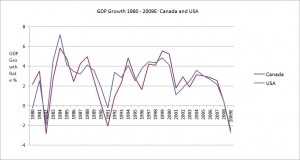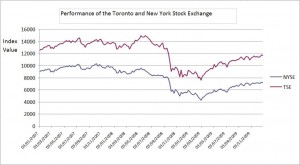Recently the Bank of Canada reiterated its promise to keep borrowing rates unchanged through June 2010. While there are many valid arguments in favor of the decision and some against, an underlying theory is that the Bank of Canada is waiting for the US Federal Reserve to increase rates. While concern about what the Fed is going to do is acceptable, Canada doesn’t need to make its policy based on US actions.
Historically, the performances of the two economies are linked. The GDP growth rates of the two countries for the period from the 1980 – 2009E exhibit a Pearson correlation coefficient of 0.83. The graph below sets out the GDP growth rates of the two economies.
Source: International Monetary Fund, World Economic Outlook Database, October 2009
Historically the stock markets too have seen a strong correspondence. The weekly trading data in the three years from 2007 to 2009 of the Toronto Stock Exchange (S&P/TSX Composite index) and the New York Stock Exchange (NYSE Composite Index) indicate a Pearson co-efficient of 0.96. The performance of the two indices is as follows:
Source: Yahoofinance.com
However, the past year has shown that Canada can strike out on its own. Canada’s economy is recovering well, the mortgage default rates are comparatively very low, the banking system is safe and sound, in fact the World Economic Forum ranks it as the world’s most sound banking system (The US is ranked number 40). The IMF forecasts its unemployment in the year 2010 (8.647%) to be lower than the US’s (10.146%), The IMF also forecasts Canadian GDP growth (2.125%) to be higher than the US’s (1.518%) in 2010. Low mortgage rates have helped fuel a 67% increase in existing home sales in November from their January 2009 low (Bloomberg.com). Furthermore, at a time where distance from the US has helped economic health. Canada with its’ very strong trade ties to the USA has escaped the worst. While US will always be a big player and Canada’s closest trading partner; the economic landscape is changing.
BRICS (Brazil, Russia, India and China) and the emerging markets are the future drivers of growth. Goldman Sachs forecasts “by 2010 BRICs will contribute almost half of global consumption growth. In particular, China will contribute almost 30% of global consumption growth, more than the G3 and almost double that of the US.” The financial crisis has been a test for the solidity of BRICs, and China and India in particular have withstood the test well. Canada’s primary industries of oil, natural gas, agriculture and metals now have a huge market in China. Furthermore the emerging countries are now entering a phase of healthy economic development driven by domestic demand and consumption. Their demand for import items are also changing; with more high value goods being demanded. Canada has many opportunities to tap. It’s a good time to reduce the dependence on the US and venture out.
This article was written by Gayani S. B.Sc., CFA, ACMA an ex-investment banker with experience as an analyst in the shipping sector.
{ 4 comments }








